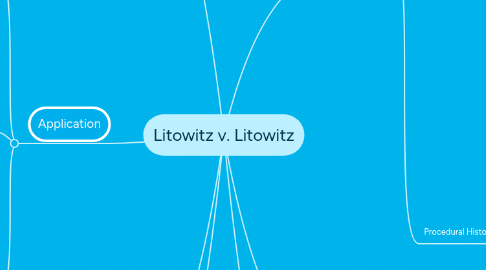
1. Influence
1.1. This case has impact bussiness of healthcare that deals with invitro fertilization. Contracts need to be written considering the circumstances beyond the current situation of the couple. The contract for egg/sperm donors, surrogate mothers, cryopreservation laboratories etc.
2. Application
2.1. Petitioner
2.1.1. The contract should be executed and the two frozen pre-embryos be brought to life as she has the right of parenting to these pre-embryos
2.1.2. The two frozen pre-embryos cannot be put for adoption as per the agreements between the couple and between the couple and the egg donor
2.1.3. The contract is valid even after the divorce
2.2. Respondent
2.2.1. There is no provision in the contract that defines rights of either party after divorce
2.2.2. The contact with the egg donor does not mention donor's rights regarding adoption
2.2.3. The frozen pre-embryos fate should be decided under the provisions of cryopreservation agreement
2.3. Court
2.3.1. There is no provision in the contract describing legal route after separation
2.3.2. No clause exists in the contract if the couple will bring the pre-embryos to life after divorce
2.3.3. The court ruled in favor of the respondent to have the custody of the embryos and that the embryos should be thawed to expire as already five years have passed
3. Facts
3.1. Parties
3.1.1. Becky M. LITOWITZ, Petitioner
3.1.1.1. Becky is the ex wife of David J. LITOWITZ, they married in 1982
3.1.2. David J. LITOWITZ, Respondent
3.1.2.1. David is the ex husband of Becky
3.1.2.2. Wanted to give the two frozen pre-embroys for adoption
3.1.2.3. Trial court ruled in favor of David
3.2. What Happened
3.2.1. The marriage lasted for 15 years
3.2.1.1. She has one biological child, Jacob, from David. Following his birth she got hysterectomy done on her
3.2.1.2. After given birth to Jacod she got hysterectomy done on her
3.2.1.3. David adopted her two children from previous marriage
3.2.2. Later on, the couple decided to have assisted pregnancey with donor eggs and a surrugate mother, David being biological father as his sperm used to fertilize the egg
3.2.3. Surrogate mother, cryopreservation, invitro fertilization at Loma Linda Center
3.2.3.1. A surrogate mother was found and contracted.
3.2.3.2. A contract was also signed by the couple and Loma Linda Center, stating that both husban and wife will decide the future of hte frozen pre-embroys and that in case of a dispute court will decide.
3.2.3.3. Out of five embroys, two were frozen and three were implanted
3.2.4. The surrugate mother was pregnant when the couple got divorced and a female child was born
3.2.5. Becky wanted to get the two frozen pre-embroys be implanted in the surrogate mother to term
3.3. Procedural History
3.3.1. Trial court dicided in the favor of David, the respondent, giving him the custody of the frozen pre-embroys
3.3.2. Court of appeals upheld trial court's decision
3.3.3. The petitioner appealed in the US supreme court at Washington
3.3.4. The petitioner files for review appeal
4. Conclusion
4.1. Trial court's judgment was upheld
5. Issue before the court
5.1. Is the decision to upheld the trial court's decision by the court of appeal correct?
6. Rule of Law
6.1. Law
6.1.1. Contracts: Expressed & Implied
6.1.2. Legal agreement existed regarding how the decision to be made about the frozen pre-embryos
6.1.3. Whether either parent be deprived of parenthood
6.1.4. Right to privacy (4th amendment)
6.2. Precedents
6.2.1. Stowe v Davis
6.2.1.1. Court rule that an agreement exist (although there was no written agreement available)
6.2.2. Kass v Kass
6.2.2.1. Court give the custody of the pre-embroys to reseach lab based on the contract
7. Impct
7.1. The case highlighted the complexities of reproductive technologies that revolve around egg and sperm donation, cryofreezing of eggs, sperms, & pre-embryos, surrogate mothers and much more
7.1.1. Trial courts ruled on cases (Roman v Roman) depending on this case's ruling
